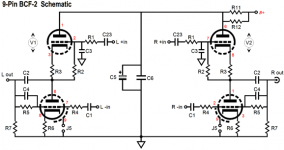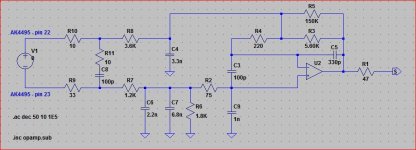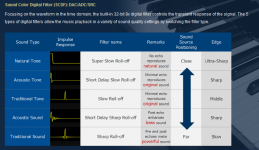Bernie, my board is 1.1 and I confirm R2 is 75 Ohm, R8 is 3.6k and R4 is 220 Ohm. I think the 150k is aimed at fine tuning the gain and filter.
The gain is the pic attached, it should be correct but it's a very long time I haven't made those kinds of calculation..... Notice that R20=R3//R5
On my board it's near +3dB. Cut frequency is around 105kHz.
I've fixed an error in the layout and changed the diagram in order to get it closest to the output stage of the DAC. (differential with DC offset)
Please also fin a plot with your values of R2, R8 and R4 : bernieplot.jpg
Much thanks! 3dB gain doesn't seem so much yet it's quite a bit louder than most DACs. Are they mostly unity gain?
More gain
Hi guys , I run a passive buffered preamp. I decided to replace the AD827 OPAMP in the dac output stage with a valve based balanced to single ended unity gain converter by tapping the +and - inputs to the opamp. This works but has resulted in a large drop in gain compared to using the opamp.
Can I recover some gain by tapping the signal at the dac chip outputs ie at the input side of resistors R9 AND R10 as per the schemmatic(fig2)?
Do I need any added resistance or capacitance between the dac chip outputs and the input of the valve board ?The valve board is ACcoupled and the input resistors to the grid are 47k ohms.
Can I implement a passive low pass filter @80khz between dac output and valve board and what values of Rand C should I use.
Thanks in advance,
Gordon
Hi guys , I run a passive buffered preamp. I decided to replace the AD827 OPAMP in the dac output stage with a valve based balanced to single ended unity gain converter by tapping the +and - inputs to the opamp. This works but has resulted in a large drop in gain compared to using the opamp.
Can I recover some gain by tapping the signal at the dac chip outputs ie at the input side of resistors R9 AND R10 as per the schemmatic(fig2)?
Do I need any added resistance or capacitance between the dac chip outputs and the input of the valve board ?The valve board is ACcoupled and the input resistors to the grid are 47k ohms.
Can I implement a passive low pass filter @80khz between dac output and valve board and what values of Rand C should I use.
Thanks in advance,
Gordon
Attachments
Hi Ozcal,
I know very few about valves, but I'm sure you can’t replace an opamp by a unity gain amp with 47k input impedance. But I believe you may replace the whole AOP output stage by your valve's one. On our board the analog out stage (internal) of the AK4495 is powered at 6,7v and the output voltage is 2*2,8V peak to peak. Each minus and plus output has a DC bias of 6,7v/2 so you need cap (high quality ones) for coupling. You may try to remove all component of the right of R11/C8 and plug your valve AC coupled on the R10/R11 node and R9C8 node. Then you should build a 2nd order low pass filter after your valve converter. Or you may build a 3rd order one if you remove C8/R11.
Have a look to the following thread : http://www.diyaudio.com/forums/digi...entations-alternative-post-dac-filtering.html it may contains good insights for you.
Have also a look to the 4495 datasheet, out impedance is not given but load resistor should not be lower than 1k and load cap higher then 25pF.
I know very few about valves, but I'm sure you can’t replace an opamp by a unity gain amp with 47k input impedance. But I believe you may replace the whole AOP output stage by your valve's one. On our board the analog out stage (internal) of the AK4495 is powered at 6,7v and the output voltage is 2*2,8V peak to peak. Each minus and plus output has a DC bias of 6,7v/2 so you need cap (high quality ones) for coupling. You may try to remove all component of the right of R11/C8 and plug your valve AC coupled on the R10/R11 node and R9C8 node. Then you should build a 2nd order low pass filter after your valve converter. Or you may build a 3rd order one if you remove C8/R11.
Have a look to the following thread : http://www.diyaudio.com/forums/digi...entations-alternative-post-dac-filtering.html it may contains good insights for you.
Have also a look to the 4495 datasheet, out impedance is not given but load resistor should not be lower than 1k and load cap higher then 25pF.
On our board the analog out stage (internal) of the AK4495 is powered at 6,7v and the output voltage is 2*2,8V peak to peak.
Notice that R20=R3//R5
On my board it's near +3dB.
Just to be sure...what voltage (rms) do the above translate to at the rca output?
If I understand you correctly, the ak4495 chip outputs 2*2.8vp-p (2vrms) and there's a further gain of 3dB at the LPF circuit, then the output is 2.85vrms.
Standard for most DACs single ended output is 2vrms.
Last edited:
purchased the weiliang ak4495+ak4118 fully assembled dac. comes with LM49860. and had the xmos usb card put on it as well. facing an issue of the vocals being a bit too bright. if there are any suggestions to sort this issue out would like to know. have read on this thread that swapping op amps help, and this was my initial thought. what op amps would be ideal. the ones that i've read that are good are the opa627, opa827 and the ad797 / ad827
thanks
not an engineer myself so no sure how to go about abraxalito's suggestion
dacster i had a similar problem when i tried to install the xmos usb card. the version that the supplier sent me wasnt working. he then sent me another version and it worked immediately
thanks
not an engineer myself so no sure how to go about abraxalito's suggestion
dacster i had a similar problem when i tried to install the xmos usb card. the version that the supplier sent me wasnt working. he then sent me another version and it worked immediately
Like many of you, I sometime feel hurt in the mids (violin, piano, voices) with my board.
By reading and reading again AKM site and datasheet I've realized that the 4495 has 5 filters linked to sound quality under marketing name 'Velvet sound'. 4 filters are associated with bit or pin SD and SLOW (the useless dipswitch) and the 5th is linked to bit pin SSLOW. But I think they are exclusive otherwise we would have 8 filters not 5!. So when SSLOW is activated (High level), which is case on our board, the pin SD and SSLOW are useless, again !, even with jumper rather than dip switch (see my previous posts).
Picture show sample of AKM website about filtering.
I'll try to mod pin SSLOW (pin 5) this week end and then to evaluate the real effect of Slow and SD. It should connected to Vss not only opened because there's an internal pullup resistor.
By reading and reading again AKM site and datasheet I've realized that the 4495 has 5 filters linked to sound quality under marketing name 'Velvet sound'. 4 filters are associated with bit or pin SD and SLOW (the useless dipswitch) and the 5th is linked to bit pin SSLOW. But I think they are exclusive otherwise we would have 8 filters not 5!. So when SSLOW is activated (High level), which is case on our board, the pin SD and SSLOW are useless, again !, even with jumper rather than dip switch (see my previous posts).
Picture show sample of AKM website about filtering.
I'll try to mod pin SSLOW (pin 5) this week end and then to evaluate the real effect of Slow and SD. It should connected to Vss not only opened because there's an internal pullup resistor.
Attachments
Just to be sure...what voltage (rms) do the above translate to at the rca output?
If I understand you correctly, the ak4495 chip outputs 2*2.8vp-p (2vrms) and there's a further gain of 3dB at the LPF circuit, then the output is 2.85vrms.
Standard for most DACs single ended output is 2vrms.
Bernie,
You were right, this was high. I did a mistake. I currently think that differential output is 2,8 Vpp (2*1,4Vp) multiplied by (VREFH-VREFL)/5. where VREFH-VREFL=VDD=6,7V (see datasheet page 9). So differential output of 4495 is 3,75 Vpp or 1,32 Vrms; with further gain of 3dB by the ampop, the output of the board is 1,87 Vrms.
Like many of you, I sometime feel hurt in the mids (violin, piano, voices) with my board.
By reading and reading again AKM site and datasheet I've realized that the 4495 has 5 filters linked to sound quality under marketing name 'Velvet sound'. 4 filters are associated with bit or pin SD and SLOW (the useless dipswitch) and the 5th is linked to bit pin SSLOW. But I think they are exclusive otherwise we would have 8 filters not 5!. So when SSLOW is activated (High level), which is case on our board, the pin SD and SSLOW are useless, again !, even with jumper rather than dip switch (see my previous posts).
Picture show sample of AKM website about filtering.
I'll try to mod pin SSLOW (pin 5) this week end and then to evaluate the real effect of Slow and SD. It should connected to Vss not only opened because there's an internal pullup resistor.
Yes I felt the mid frequencies are a bit prominent compared to my other DACs. I use the DEQ2496 equaliser for room EQ, so I use its parametric equaliser to attenuate by 3dB at 1khz, 3/4 octave spread. The resulting midrange is much more agreeable now.
I too suspected that with 5 filters and SSLOW fixed on the board, its jumper pins are useless. Look forward to your investigation.
I removed SSLOW, much better !
I haven't done extensive testing, but currently medium from piano or violin aren't 'agressive' anymore at least with Short delay filter Sharp or Slow roll off.
Please share your results if doing the mod
That's good news. Did you ground the SSLOW pin or leave it floating? Share with a photo please. Thanks.
Like many of you, I sometime feel hurt in the mids (violin, piano, voices) with my board.
By reading and reading again AKM site and datasheet I've realized that the 4495 has 5 filters linked to sound quality under marketing name 'Velvet sound'. 4 filters are associated with bit or pin SD and SLOW (the useless dipswitch) and the 5th is linked to bit pin SSLOW. But I think they are exclusive otherwise we would have 8 filters not 5!. So when SSLOW is activated (High level), which is case on our board, the pin SD and SSLOW are useless, again !, even with jumper rather than dip switch (see my previous posts).
Picture show sample of AKM website about filtering.
I'll try to mod pin SSLOW (pin 5) this week end and then to evaluate the real effect of Slow and SD. It should connected to Vss not only opened because there's an internal pullup resistor.
Are you positive pin 5, SSLOW, is high? I have the XMOS input version, and mine is tied to ground i.e. SSLOW is disabled.
as with most users of the weiliang ak4495+ak4418, i too experienced some harshness and inconsistencies with the dac. did a bit of research and and then was put on to fm linuxguru. linuxguru makes his own opamp which is a discrete opamp labelled LF03D. with reviews on other sites and after speaking with siva (linuxguru) i decided to go with unit
its an easy installation - pull out the old opamp and pin this one in. whatever apprehensions i had with the dac were ironed out after this change. the sound is more dynamic and airy now. there was a slight flabbiness around the edges previously which is now tightened up, also resulting in better sound separation. and overall it sounds much more refined and smoother now. and whatever inconsistencies that were there previously have now gone away. definitely worth the upgrade. the inconsistencies used to stand out previously and now im enjoying the music a lot more. it has brought a lot more balance to the overall sound.
its an easy installation - pull out the old opamp and pin this one in. whatever apprehensions i had with the dac were ironed out after this change. the sound is more dynamic and airy now. there was a slight flabbiness around the edges previously which is now tightened up, also resulting in better sound separation. and overall it sounds much more refined and smoother now. and whatever inconsistencies that were there previously have now gone away. definitely worth the upgrade. the inconsistencies used to stand out previously and now im enjoying the music a lot more. it has brought a lot more balance to the overall sound.
It is heard that 2 x 4495 DAC has just passed test.
The moment it is completed, I will show you the new DAC board
That's good news, when you show it?
Charon
- Status
- This old topic is closed. If you want to reopen this topic, contact a moderator using the "Report Post" button.
- Home
- Source & Line
- Digital Line Level
- Finally Weiliang released ak4495+ak4118 dac today.


